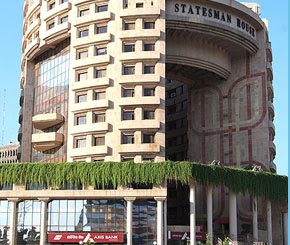Barakhamba

Information on Barakhamba (New Delhi) - History & Architecture
Barakhamba is also referred as the Barakhamba Monument which is building with a tomb and belongs to the Lodi period of 14th century. The monument is situated in New Delhi, India. The name of the monument stands for twelve pillars in both Hindi and Urdu languages. The name of the monument has even been shared for a recent posh metro road in the name of "Barakhamba road" located in Connaught Place which is considered to be the main part of the city. The Barakhamba monument is believed to be the burial place of an unidentified individual, assumingly of an aristocrat. It is precisely situated in the heritage region of Nizamuddin which is at the entry road leading to Nizamuddin Auliya.
Barakhamba Architecture
The monument has twelve strong pillars along with three curved openings on every face. The design of the tomb is based on the distinctive architectural pattern common in the Lodi era. A running passage surrounds the main chamber and also includes four arched accommodations in each of the corner. The monument is constructed inside a park open to the public. The Barakhamba lies just opposite to the course particular to the 7th Hole of the Delhi Golf Club and also on the central road which runs to the Humayun tomb from the Nizamuddin or the Neel Gumbad circle.
Till a considerable period of time, the Barakhamba complex lied neglected and used to be full off unlawful residents, however, a restitution of the monument was undertaken in this regard. The monument was even ruined by graffiti and betel leaf spits on its walls by the ruffians. The initiation of the restoration programme helped in throwing out the squatters along with making the area additionally secure. Attempts were made in order to reinstate the monument and re-establishing its long lost glory. The restoration plans including remodelling the garden in the region of the tomb as well as the park. The initial drive taken by the Archaeological Survey of India called for the necessity of doing away with the scars as well as blemishes. This involved a process of chemical treatment which entailed the appliance of an exceptional form of paste on the entire monument for numerous times in order to wipe out the marks which would further aid in bringing back the monument's original look. The subsequent step related to restoration work entailed working on the constructional restoration of the monument. The restoration programme of the monument was completed prior to the commencement of the Commonwealth Games, which was conducted in the year 2010 in New Delhi.
Barakhamba History
It was deduced from the historical records and research works that the square monument based on twelve pillars may have in fact been a grave compartment surrounded with precincts, formerly planned as Chausath Khamba. The Lalmahal is again a monument made of red coloured sandstone which is situated behind the Barakhamba and is in a damaged condition presently along with being partly destroyed. The Lal Mahal is a heritage structure which is also known as Kaushak Lal and was erected by a ruler in the name of Balban from the Slave Dynasty during the period of 1266 to 1286. This structure of red coloured sandstone had outstanding chhatris which were pulled down.
Barakhamba Tourism Significance
The Barakhamba monument is amongst the 46 historical structures chosen by the ASI for restoration purpose. The Barakhamba monument was provided an "A" Grade by the Indian National Trust for Art and Cultural Heritage (INTACH) owing to its heritage value and therefore, attracts quite a significant number of tourists. It is worth to pay visit, while in Delhi for historical tour or a visit to Delhi the capital city of India.
- Andaman Nicobar Monuments
- Andhra Pradesh Monuments
- Assam Monuments
- Bihar Monuments
- Chhattisgarh Monuments
- New Delhi Monuments
- Goa Monuments
- Gujarat Monuments
- Haryana Monuments
- Himachal Pradesh Monuments
- Jammu and Kashmir Monuments
- Karnataka Monuments
- Kerala Monuments
- Madhya Pradesh Monuments
- Maharashtra Monuments
- Odisha Monuments
- Punjab Monuments
- Rajasthan Monuments
- Tamil Nadu Monuments
- Telangana Monuments
- Uttar Pradesh Monuments
- West Bengal Monuments